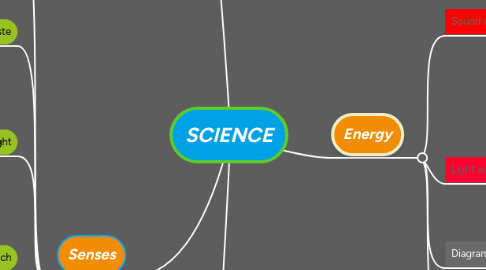
1. Units
1.1. Units are a MUST for scientific/technological and just general Progress. Units are used to measure different aspects. They help us understand exactly how fast/slow tall/short loud/quiet something is. Using the same units is also important for example 10 yards and 10 meters can result in incorrect information and results. They might say something is 10 meters away which means...This and that BUT it's actually 9 meters away.
1.2. Distance/Length
1.2.1. Milimeters x 10 v
1.2.2. Centimeters x 100 v
1.2.3. Meters x 1000 v
1.2.4. kilometers
1.3. Sound
1.3.1. DB: Volume
1.3.2. Hz : (Hertz) Frequency
1.4. Volume
1.4.1. Milliliter 1000x v
1.4.2. LIiter
1.5. Weight
1.5.1. gram 1000x v
1.5.2. Killogram
1.6. Time
1.6.1. second 60x v
1.6.2. minute 60x v
2. Energy
2.1. Sound waves
2.1.1. Sound waves are Longitudinal waves Which travel in straight lines at 340 m/s approximately. They are travelling vibrations of particles in that originate from vibrations they pass through air, water or metal. So they cannot travel through empty space (that has no particles to vibrate.) sound travels better through denser mediums because the particles are closer together so they vibrations are passed more efficiently from particle to particle.
2.2. Light waves
2.2.1. Light waves are transverse wave that travels in a straight line at 300,000,000m/s approximately. Light waves are apart of the electro magnetic spectrum which includes: radio waves, micro waves, infrared, ultra violet, x-rays and gamma rays. Unlike sound waves light waves do not require a medium or substance to travel; so they can travel through vacuums.
2.3. Diagrams
2.3.1. https://docs.google.com/document/d/1zFk1bNxya11B4RU9s2US2d_WOtVrBJvyVxUFzMcL0zw/edit?usp=sharing
2.4. Hz (herts) frequency
2.4.1. Frequency Is how Often a wavelength occurs in a length of time (1 second). So one Hz is one wavelength per second.
3. Senses
3.1. Smell
3.1.1. When your nose sniffs in molecules they travel through your nose ( which is 95% filters through your nose) to the top. At the top is the olfactory epithelium ( a layer of olfactory receptor cells) covered in mucus. They mucus dissolves the molecules, they are then sent to the olfactory tract: then to the brain.
3.2. Taste
3.2.1. The tongue Has 3 types of receptors(piplatte) Circumvallate: Bitter And Sour Taste Filiform: Sour only Fungi form: Sweet and salty Taste Food cells have to go through the taste buds and match with the uniquely shaped cells to send information to the brain through cranial nerves. -(cranial nerves regenerate these cells around every two weeks (10-14 days))
3.3. Sight
3.3.1. Light goes through the pupil (black hole) into the eye. The lens focuses the light on the retina at the back of the eye. The retina contains rods and cones which process the information; then send it to the brain via the optic nerve.
3.4. Touch
3.4.1. Touch receptors are all over again your body and not restricted to just one organ/body-part. The bottom most layer of your skin is called the dermis, it senses touch. Nerve endings collect and process information from touch, they fill the dermis. There are four main receptors that process and send information to the brain,They are: Heat, Cold, Pain and Pressure
3.5. Hearing
3.5.1. When sound waves travel through the air the pinna (outer ear) focuses it into you auditory canal (inner ear) when the sound hits your eardrum (stretched membrane) the eardrum vibrates. The vibrations are sent to the three smallest bones hammer, anvil and the stirrup, In respective order. This finally passes along the cochlea (coiled tube) Inside that are cilia: they vibrate with the cochlea and send electric signals to the brain through the auditory nerve.
3.5.2. Limitations
3.5.2.1. Human Senses are also limited, not all levels of Frequency and DB can be heard the human ear. there is lots the human eye cannot see Eg bacteria and some forms of energy. etc so we need tools to find things we cant perceive.
3.5.3. New node
4. Colour and Reflection/Refraction
4.1. Colour
4.1.1. White light is all the colours of the spectrum combined R,O,Y,G,B,I,V. Different things absorb different colours. An objects colour is based on what it absorbs and what it reflects. So so something that absorbs royiv and not g and b (green and blue). g and b are reflected so we see them as cyan.
4.2. Reflection
4.2.1. Reflection is when a wave is redirected. The incident ray hits the surface then is bounced back at the same angle as the incident ray. this angle is matched with the normal. the normal is 90 degrees to the surface where the wave hits.
4.3. Refraction
4.3.1. Refraction is when a wave passes through a medium but is redirected. when the wave hit the new medium the same normal is created. when light is passing through this new medium it bends toward the normal as it slows down. the wave then bends AWAY from the normal as it leaves the medium.
